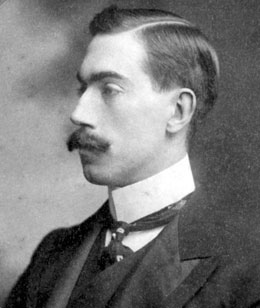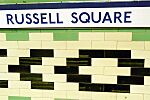Leslie Green facts for kids
Quick facts for kids
Leslie Green
|
|
|---|---|

Leslie Green, c. 1906
|
|
| Born |
Leslie William Green
6 February 1875 Maida Vale, London
|
| Died | 31 August 1908 (aged 33) |
| Education | Dover College, South Kensington School of Art |
| Occupation | Architect |
| Known for | London Underground stations |
| Spouse(s) | Mildred Ethel Wildy (m.1902) |
| Children | Vera (daughter) |
| Awards | Fellow of the RIBA |
Leslie William Green (born February 6, 1875 – died August 31, 1908) was a talented English architect. He is famous for designing many of the early London Underground stations. These stations, built in central London in the early 1900s, have a special look. They feature deep red blocks, round windows, and cool tiled patterns inside.
Contents
Early Life and Family
Leslie Green was born in Maida Vale, London, in 1875. He was the second of four children. His father, Arthur Green, was also an architect.
Leslie studied at Dover College and the South Kensington School of Art. He also spent time studying in Paris. Between his studies, he worked as an assistant in his father's architecture office.
In April 1902, Green married Mildred Ethel Wildy. They had a daughter named Vera in 1904.
Designing London's Tube Stations
Green started his own architecture business in 1897. He first worked from his father's office. Later, he moved his office to Haymarket and then to Adam Street. In 1898, he became an associate of the Royal Institute of British Architects (RIBA). He became a full member in 1899.
In 1903, a big company called the Underground Electric Railways Company of London (UERL) hired Green. They wanted him to design stations for three new underground railway lines. These lines are now parts of the Piccadilly line, Bakerloo line, and Northern line. Green was asked to design 50 new stations. This included their outside look and their inside decorations.
Green created a unique style for the station buildings. Each station's design fit its specific location. The buildings had two floors and a strong steel frame. This was a new way to build, coming from the United States. The steel frame allowed for large spaces inside for ticket halls and lift shafts.
The outside of the stations was covered in special deep red (called ox-blood red) glazed terracotta blocks. These blocks were made by the Burmantofts Pottery. The ground floor had wide sections with columns. This allowed for separate entrances and exits. It also made space for small shops. The design also featured large, round windows on the first floor. A wide strip between the two floors showed the station's name in big letters. The station buildings had flat roofs. This was planned so that office buildings could be built on top later.
The inside of the stations was tiled in green and white. There were also decorative details. At the platform level, each station had a special tiling design. This design included the station name. Each station had its own unique color scheme and geometric tile patterns. These patterns repeated along the platform. Signs for directions were also part of the tile designs. The tiled surfaces made all the stations look connected. They were also easy to keep clean.
The new railways opened in 1906 and 1907. Green's contract ended in 1907. In the same year, he became a Fellow of the RIBA. He included his work for the UERL in his application.
Many of Green's station buildings are still standing today. While some inside parts have changed, many original tiling designs remain. Some have even been copied to look like the originals. Several of his buildings are now special listed buildings. These include Aldwych, Belsize Park, and Russell Square. His assistant, Stanley Heaps, continued his work. Green's designs are still easy to spot. For example, the fictional Walford East station in the TV show EastEnders looks like one of Green's designs.
Leslie Green Stations
|
Bakerloo line Stations built by BS&WR with Leslie Green's designs:
|
Piccadilly line Stations built by GNP&BR with Leslie Green's designs:
|
Northern line Stations built by CCE&HR with Leslie Green's designs:
|
Death
Leslie Green became sick with tuberculosis. He passed away on August 31, 1908, at a special hospital in Mundesley-on-Sea, Norfolk.
See also
- Charles Holden, another architect known for his work on London Underground railway stations in the decades following Green’s death



